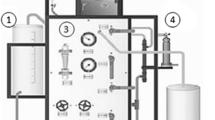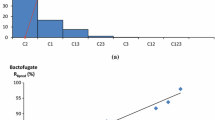Abstract
An important factor resulted from the ascension of the milk and milk-based by-products production is many effluents directly released into the environment. The main objective of this study was to evaluate the efficiency of the combination of the chemical coagulation, with ferric chloride as a coagulant, and the membrane separation processes (MSP) and reverse osmosis (RO) processes in the treatment of effluents from a powdered milk dairy industry. To evaluate the effectiveness of the integration of these mechanisms, the characterization of the effluents was carried out through Total Nitrogen (Ntotal), Total Organic Carbon (TOC), Chemical Oxygen Demand (COD), color, pH, and turbidity analysis. Regarding the treatments with ferric chloride, the Ntotal removal was up to 55.7% (concentration of 1.2 g L− 1) and the color up to 50% (0.7 g L− 1). For the MSP and RO treatments, the color removal was up to 100% (1st RO), turbidity up to 100% (1st RO), COD up to 98.7% (3rd RO), and TOC up to 96.7% (3rd RO). Finally, the integration of the chemical coagulation and MSP processes was efficient for the treatment of dairy industry wastewater and provides the return of water in appropriate characteristics according to legislation.




Similar content being viewed by others
Data availability
Not applicable.
Code availability
Not applicable.
References
Abdelfattah A, Hossain MI, Cheng L (2020) High-strength wastewater treatment using microbial biofilm reactor: a critical review. World J Microbiol Biotechnol 36:1–10. https://doi.org/10.1007/s11274-020-02853-y
Ahmad T, Aadil RM, Ahmed H et al (2019) Treatment and utilization of dairy industrial waste: a review. Trends Food Sci Technol 88:361–372. https://doi.org/10.1016/j.tifs.2019.04.003
APHA (2005) Standard methods for the examination of water and wastewater, 21st edn. American Public Health Association/American Water Works Association/Water Environment Federation, Washington DC
Biniaz P, Ardekani NT, Makarem MA, Rahimpour MR (2019) Water and wastewater treatment systems by novel integrated membrane distillation (MD). ChemEngineering 3:1–36. https://doi.org/10.3390/chemengineering3010008
Bortoluzzi AC, Faitão JA, Di Luccio M et al (2017) Dairy wastewater treatment using integrated membrane systems. J Environ Chem Eng 5:4819–4827. https://doi.org/10.1016/j.jece.2017.09.018
Bouchareb R, Derbal K, Özay Y et al (2020) Combined natural/chemical coagulation and membrane filtration for wood processing wastewater treatment. J Water Process Eng 37:101521. https://doi.org/10.1016/j.jwpe.2020.101521
Ceni G, Dallago RM, Mores R et al (2019) Avaliação da eficiência do cloreto férrico como coagulante no tratamento de um efluente sintético pelo método convencional e eletrocoagulação. Vivências 16:77–97. https://doi.org/10.31512/vivencias.v16i30.108
Conselho Nacional do Meio Ambiente - CONAMA (2011) Resolução N° 430, de 13 de Maio de 2011. Brazil
Cruz M, Jakobs-schoenwandt D, Isabel M et al (2020) Formulating bacterial endophyte: pre-conditioning of cells and the encapsulation in amidated pectin beads. Biotechnol Rep 26:e00463
de Melo JRM, Tres MV, Steffens J et al (2015) Desolventizing organic solvent-soybean oil miscella using ultrafiltration ceramic membranes. J Memb Sci 475:357–366. https://doi.org/10.1016/j.memsci.2014.10.029
Ensano BMB, Borea L, Naddeo V et al (2016) Combination of electrochemical processes with membrane bioreactors for wastewater treatment and fouling control: a review. Front Environ Sci. https://doi.org/10.3389/fenvs.2016.00057
Ezugbe EO, Rathilal S (2020) Membrane technologies in wastewater treatment: a review. Membranes (Basel) 10(5):89. https://doi.org/10.3390/membranes10050089
FAO (2019) World food and agriculture - statistical pocketbook 2019, 2019th edn. Organization of the United Nations (FAO), Rome
Gil-Pulido B, Tarpey E, Almeida EL et al (2018) Evaluation of dairy processing wastewater biotreatment in an IASBR system: aeration rate impacts on performance and microbial ecology. Biotechnol Rep 19:e00263. https://doi.org/10.1016/j.btre.2018.e00263
Grout L, Baker MG, French N, Hales S (2020) A review of potential public health impacts associated with the global dairy sector. GeoHealth 4:1–46. https://doi.org/10.1029/2019gh000213
Kurup GG, Adhikari B, Zisu B (2019) Treatment performance and recovery of organic components from high pH dairy wastewater using low-cost inorganic ferric chloride precipitant. J Water Process Eng 32:100908. https://doi.org/10.1016/j.jwpe.2019.100908
Li X, Liu Y, Liu F, Liu A, Feng Q (2017) Comparison of ferric chloride and aluminum sulfate on phosphorus removal and membrane fouling in MBR treating BAF effluent of municipal wastewater. J Water Reuse Desalin 7(4):442–448. https://doi.org/10.2166/wrd.2016.151
Mateus GAP, Formentini-Schmitt DM, Nishi L et al (2017) Coagulation/flocculation with Moringa oleifera and membrane filtration for dairy wastewater treatment. Water Air Soil Pollut 228(9):1–13. https://doi.org/10.1007/s11270-017-3509-z
Meiramkulova K, Devrishov D, Zhumagulov M et al (2020) Performance of an integrated membrane process with electrochemical pre-treatment on poultry slaughterhouse wastewater purification. Membranes (Basel) 10:1–17. https://doi.org/10.3390/membranes10100256
Nabbou N, Benyagoub E, Mellouk A, Benmoussa Y (2020) Risk assessment for chemical pollution of dairy effluents from a milk processing plant located in Bechar (Southwest of Algeria). Appl Water Sci 10:1–12. https://doi.org/10.1007/s13201-020-01309-w
Prakash N, Garg A (2016) Comparative performance evaluation of physicochemical treatment processes for simulated dairy wastewater. Int J Environ Sci Technol 13:2675–2688. https://doi.org/10.1007/s13762-016-1099-8
Precious Sibiya N, Rathilal S, Kweinor Tetteh E (2021) Coagulation treatment of wastewater: kinetics and natural coagulant evaluation. Molecules 26:698. https://doi.org/10.3390/molecules26030698
Rufus DP, Banu JR, Kannah RY et al (2019) Effect of dispersion treatment on dairy waste activated sludge to hasten the production of biogas. Front Energy Res 7:1–9. https://doi.org/10.3389/fenrg.2019.00136
Sarkar B, Chakrabarti PP, Vijaykumar A, Kale V (2006) Wastewater treatment in dairy industries - possibility of reuse. Desalination 195:141–152. https://doi.org/10.1016/j.desal.2005.11.015
Turan M (2004) Influence of filtration conditions on the performance of nanofiltration and reverse osmosis membranes in dairy wastewater treatment. Desalination 170:83–90. https://doi.org/10.1016/j.desal.2004.02.094
Funding
The authors thank URI Erechim, National Council for Scientific and Technological Development (CNPq) [Grants Numbers 308936/2017-5; 428180/2018-3; 306241/2020-0], Coordination for the Improvement of Higher Education Personnel (CAPES) [Grant Number 001] and Research Support Foundation of the State of Rio Grande do Sul (FAPERGS) [Grant Number 16/2551-0000522-2].
Author information
Authors and Affiliations
Contributions
AC, RD, and JS conceptualized the study. All authors analyzed, interpreted the data and wrote the manuscript. All authors read and approved the final manuscript.
Corresponding author
Ethics declarations
Conflict of interest
The authors declare no conflict of interest.
Ethical approval
Not applicable.
Consent to participate
Not applicable.
Consent for publication
Not applicable.
Additional information
Publisher’s Note
Springer Nature remains neutral with regard to jurisdictional claims in published maps and institutional affiliations.
Rights and permissions
Springer Nature or its licensor holds exclusive rights to this article under a publishing agreement with the author(s) or other rightsholder(s); author self-archiving of the accepted manuscript version of this article is solely governed by the terms of such publishing agreement and applicable law.
About this article
Cite this article
Bortoluzzi, A.C., Demaman Oro, C.E., dos Santos, M.S.N. et al. Combination of chemical coagulation and membrane-based separation for dairy wastewater treatment. J Food Sci Technol 60, 84–91 (2023). https://doi.org/10.1007/s13197-022-05590-2
Revised:
Accepted:
Published:
Issue Date:
DOI: https://doi.org/10.1007/s13197-022-05590-2




